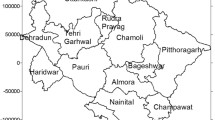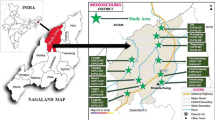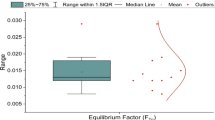Abstract
A variety of toxins are known to affect indoor air quality, thereby affecting the health of the inhabitants of that region. One such natural contaminant is radon, which is a dense, colourless, odourless and inert gas. As per BEIR-VI report (Chauhan and Chauhan in J Environ Radioact, 2015. https://doi.org/10.1016/j.jenvrad.2015.03.009), Radon alone contributes to more than 50% of the total natural background radiation and is the second leading element causing lung cancer after smoking. Therefore, its quantification is vital to assess any risk to human health. In order to assess health risks, a recently developed LR-115 detector based technique was employed for time-integrated passive measurements of radon, thoron and their progeny concentrations. The annual average radon concentration was found to be 35.6 Bq m−3 and thus lies well below the global average of 40 Bq m−3. However, thoron concentration exceeded the global average value of 10 Bq m−3.
Similar content being viewed by others
References
Chauhan N, Chauhan RP (2015) Active-passive measurements and CFD based modelling for indoor radon dispersion study. J Environ Radioact. https://doi.org/10.1016/j.jenvrad.2015.03.009
Nazaroff WW (2013) Exploring the consequences of climate change for indoor air quality. Environ Res Lett. https://doi.org/10.1088/1748-9326/8/1/015022
Burnett WC, Kim G, Lane-Smith D (2001) A continuous monitor for assessment of 222Rn in the coastal ocean. J Radioanal Nucl Chem 249:167–172
Moran SB, Dulaiova H (2013) Marine Chemistry special issue: radium and radon tracers in aquatic systems: an update. Mar Chem 156:1–2
Khan HA (1993) Usefulness of radon measurements in earth sciences. Nucl Tracks Radiat Meas. https://doi.org/10.1016/0969-8078(93)90085-I
Ramola RC, Prasad Y, Prasad G et al (2008) Soil-gas radon as seismotectonic indicator in Garhwal Himalaya. Appl Radiat Isot 66:1523–1530. https://doi.org/10.1016/j.apradiso.2008.04.006
Gingrich JE (1984) Radon as a geochemical exploration tool. J Geochem Explor 21:19–39. https://doi.org/10.1016/0375-6742(84)90032-3
Koike K, Yoshinaga T, Ueyama T, Asaue H (2014) Increased radon-222 in soil gas because of cumulative seismicity at active faults. Earth Planets Sp 66:57. https://doi.org/10.1186/1880-5981-66-57
Planinić J, Radolić V, Vuković B (2004) Radon as an earthquake precursor. Nucl Instrum Methods Phys Res Sect A Accel Spectrom Detect Assoc Equip 530:568–574. https://doi.org/10.1016/j.nima.2004.04.209
Koike K, Yoshinaga T, Ueyama T, Asaue H (2014) Increased radon-222 in soil gas because of cumulative seismicity at active faults. Earth Planets Sp. https://doi.org/10.1186/1880-5981-66-57
Tayyeb ZA, Kinsara AR, Farid SM (1998) A study on the radon concentrations in water in Jeddah (Saudi Arabia) and the associated health effects. J Environ Radioact 38:97–104. https://doi.org/10.1016/S0265-931X(97)00014-3
UNSCEAR (2000) Sources and effects of ionizing radiation, United Nations Scientific Committee on the Effects of Atomic Radiation UNSCEAR 2000 Report to the General Assembly, with Scientific Annexes
Nazaroff WW, Moed BA, Sextro RG (1988) Soil as a source of Indoor Radon, Generation, Migration, and Entry. In: Radon and its decay products in indoor W.W. Nazaroff, A.V. Nero Jr
Hassan NM, Tokonami S, Fukushi M (2011) A simple technique for studying the dependence of radon and thoron exhalation rate from building materials on absolute humidity. J Radioanal Nucl Chem. https://doi.org/10.1007/s10967-010-0665-7
Samet JM, Eradze GR (2000) Radon and lung cancer risk: taking stock at the millenium. Environ Health Perspect 108:635–641. https://doi.org/10.1289/ehp.00108s4635
Darby S, Hill D, Auvinen A et al (2005) Radon in homes and risk of lung cancer: collaborative analysis of individual data from 13 European case-control studies. BMJ 330:223. https://doi.org/10.1136/bmj.38308.477650.63
Tokonami S (2010) Why is220RN (thoron) measurement important? Radiat Prot Dosim 141:335–339
Janik M, Tokonami S, Kranrod C et al (2010) International intercomparisons of integrating radon/thoron detectors with the NIRS radon/thoron chambers. Radiat Prot Dosim. https://doi.org/10.1093/rpd/ncq230
Tokonami S, Takahashi H, Kobayashi Y et al (2005) Up-to-date radon-thoron discriminative detector for a large scale survey. Rev Sci Instrum 76:113505. https://doi.org/10.1063/1.2132270
Chen J, Tokonami S, Sorimachi A et al (2008) Preliminary results of simultaneous radon and thoron tests in Ottawa. Radiat Prot Dosim. https://doi.org/10.1093/rpd/ncm503
Janik M, Tokonami S, Kranrod C et al (2013) Comparative analysis of radon, thoron and thoron progeny concentration measurements. J Radiat Res 54:597–610. https://doi.org/10.1093/jrr/rrs129
Samet JM, Avila-Tang E, Boffetta P et al (2009) Lung cancer in never smokers: clinical epidemiology and environmental risk factors. Clin Cancer Res 15:5626–5645
Tiwari S, Chate DM, Srivastava MK et al (2012) Statistical evaluation of PM 10 and distribution of PM 1, PM 2.5, and PM 10 in ambient air due to extreme fireworks episodes (Deepawali festivals) in megacity Delhi. Nat Hazards. https://doi.org/10.1007/s11069-011-9931-4
Chakraborty T, Beig G, Dentener FJ, Wild O (2015) Atmospheric transport of ozone between Southern and Eastern Asia. Sci Total Environ. https://doi.org/10.1016/j.scitotenv.2015.03.066
Hakim ZQ, Beig G, Reka S et al (2018) Winter burst of Pristine Kashmir Valley Air. Sci Rep 8:3329. https://doi.org/10.1038/s41598-018-20601-z
Mishra R, Prajith R, Sapra BK, Mayya YS (2010) Response of direct thoron progeny sensors (DTPS) to various aerosol concentrations and ventilation rates. Nucl Instrum Methods Phys Res Sect B Beam Interact Mater Atoms 268:671–675. https://doi.org/10.1016/j.nimb.2009.12.012
Butterweck G, Schuler C, Vezzù G et al (2002) Experimental determination of the absorption rate of unattached radon progeny from respiratory tract to blood. Radiat Prot Dosim. https://doi.org/10.1093/oxfordjournals.rpd.a006103
El-Hussein A, Ahmed AA, Mohammed A (1998) Radiation dose to the human respiratory tract from inhalation of radon-222 and its progeny. Appl Radiat Isot. https://doi.org/10.1016/S0969-8043(97)10002-1
Chamberlain AC, Dyson ED (1956) The dose to the trachea and bronchi from the decay products of radon and thoron. Br J Radiol 29:317–325. https://doi.org/10.1259/0007-1285-29-342-317
Sana H (2018) Seismic microzonation of Srinagar city, Jammu and Kashmir. Soil Dyn Earthq Eng 115:578–588. https://doi.org/10.1016/j.soildyn.2018.09.028
Gavillot Y, Meigs A, Yule D et al (2016) Shortening rate and Holocene surface rupture on the Riasi fault system in the Kashmir Himalaya: active thrusting within the Northwest Himalayan orogenic wedge. Geol Soc Am Bull 128:1070–1094. https://doi.org/10.1130/B31281.1
Ahmad S, Bhat MI, Madden C, Bali BS (2014) Geomorphic analysis reveals active tectonic deformation on the eastern flank of the Pir Panjal Range, Kashmir Valley, India. Arab J Geosci 7:2225–2235. https://doi.org/10.1007/s12517-013-0900-y
Kaneda H, Nakata T, Tsutsumi H et al (2008) Surface Rupture of the 2005 Kashmir, Pakistan, earthquake and its active tectonic implications. Bull Seismol Soc Am 98:521–557. https://doi.org/10.1785/0120070073
Shah AA (2013) Earthquake geology of Kashmir Basin and its implications for future large earthquakes. Int J Earth Sci 102:1957–1966. https://doi.org/10.1007/s00531-013-0874-8
Nazir S, Simnani S, Sahoo BK et al (2020) Dose estimation of radioactivity in groundwater of Srinagar City, Northwest Himalaya, employing fluorimetric and scintillation techniques. Environ Geochem Health. https://doi.org/10.1007/s10653-020-00576-5
Amin A (2012) Land transformation analysis using remote sensing and GIS techniques (a case study). J Geogr Inf Syst 04:229–236. https://doi.org/10.4236/jgis.2012.4327
Kuchay NA, Bhat MS (2014) Analysis and simulation of urban expansion of Srinagar city. Trans Inst Indian Geogr 2249:2224–5766
Rather MI, Rashid I, Shahi N et al (2016) Massive land system changes impact water quality of the Jhelum River in Kashmir Himalaya. Environ Monit Assess 188:185. https://doi.org/10.1007/s10661-016-5190-x
Census (2011) Srinagar District: Census 2011–2019 data. In: 2011. https://www.census2011.co.in/census/district/628-srinagar.html. Accessed 13 Apr 2017
Ambraseys NN, Douglas J (2004) Magnitude calibration of north Indian earthquakes. Geophys J Int 159:165–206. https://doi.org/10.1111/j.1365-246X.2004.02323.x
Sana H, Nath SK (2017) Seismic source zoning and maximum credible earthquake prognosis of the Greater Kashmir Territory, NW Himalaya. J Seismol 21:411–424. https://doi.org/10.1007/s10950-016-9608-2
Dellow GD, Ali Q, Ali SM et al (2007) Preliminary reconnaissance report for the Kashmir earthquake of 8 October 2005. Bull New Zeal Soc Earthq Eng 40:18–24
Avouac JP, Ayoub F, Leprince S et al (2006) The 2005, Mw 7.6 Kashmir earthquake: sub-pixel correlation of ASTER images and seismic waveforms analysis. Earth Planet Sci Lett 249:514–528. https://doi.org/10.1016/j.epsl.2006.06.025
Sannappa J, Suresh S, Rangaswamy DR, Srinivasa E (2020) Estimation of ambient gamma radiation dose and drinking water radon concentration in coastal taluks of Uttara Kannada district, Karnataka. J Radioanal Nucl Chem 323:1459–1466. https://doi.org/10.1007/s10967-019-06812-2
Omori Y, Tokonami S, Ishikawa T et al (2015) A pilot study for dose evaluation in high-level natural radiation areas of Yangjiang. J Radioanal Nucl Chem, China. https://doi.org/10.1007/s10967-015-4286-z
Sahoo BK, Sapra BK, Kanse SD et al (2013) A new pin-hole discriminated 222Rn/220Rn passive measurement device with single entry face. Radiat Meas. https://doi.org/10.1016/j.radmeas.2013.08.003
Ramola RC, Prasad M, Kandari T et al (2016) Dose estimation derived from the exposure to radon, thoron and their progeny in the indoor environment. Sci Rep 6:31061. https://doi.org/10.1038/srep31061
Németh C, Jobbágy V, Kávási N et al (2010) Radon and thoron parallel measurements in dwellings nearby a closed Hungarian uranium mine. Nukleonika 55:459–462
Mishra R, Mayya YS, Kushwaha HS (2009) Measurement of 220Rn/222Rn progeny deposition velocities on surfaces and their comparison with theoretical models. J Aerosol Sci. https://doi.org/10.1016/j.jaerosci.2008.08.001
Mishra R, Mayya YS (2008) Study of a deposition-based direct thoron progeny sensor (DTPS) technique for estimating equilibrium equivalent thoron concentration (EETC) in indoor environment. Radiat Meas 43:1408–1416. https://doi.org/10.1016/j.radmeas.2008.03.002
Saïdou Tokonami S, Janik M et al (2015) Radon-thoron discriminative measurements in the high natural radiation areas of southwestern Cameroon. J Environ Radioact 150:242–246. https://doi.org/10.1016/j.jenvrad.2015.09.006
UNSCEAR (2000) Sources and effects of ionizing radiation: United Nations Scientific Committee on the Effects of Atomic Radiation. UNSCEAR 2000 Rep to Gen Assem
Khan FM, Gibbons JP (2014) Khan’s the physics of radiation therapy, 5th edn. Lippincott Williams & Wilkins, Philadelphia
NCRP (1993) Limitation of exposure to ionizing radiation. NCRP report 116. National Council on Radiation Protection and Measurements, Bethesda, MD
Thakur V, Rawat B (1992) Geological map of the Western Himalaya. The Surveyor General of India
Chandra R, Dar JA, Romshoo SA et al (2018) Seismic hazard and probability assessment of Kashmir valley, northwest Himalaya, India. Nat Hazards 93:1451–1477. https://doi.org/10.1007/s11069-018-3362-4
Acknowledgements
We appreciate the residents of Srinagar city for their kind cooperation and trust. The authors express gratitude to the editor and the three anonymous reviewers for their comments on the earlier version of the manuscript that greatly improved the structure and content of this manuscript. Special thanks to Shahbaz Ali and Shahid ul Islam for their proficient support to carry out field investigation. A sincere thank you to Essar Batool for her diligent proofreading of this manuscript.
Funding
This work was supported by the Department of Atomic Energy (DAE), Board of Research in Nuclear Sciences (BRNS), Trombay, Mumbai, India [Grant Number: 36(4)/14/48/2015-BRNS].
Author information
Authors and Affiliations
Contributions
SR and SS designed the research plan, led the development of this study, and wrote the manuscript with contributions from RM, TS, and SM. SR carried out all the radioactive surveys and sample analyses. RM and TS contributed to the data analyses and interpretation. All authors read and approved the final manuscript.
Corresponding author
Ethics declarations
Conflict of interest
On behalf of all authors, the corresponding author states that there is no conflict of interest.
Additional information
Publisher's Note
Springer Nature remains neutral with regard to jurisdictional claims in published maps and institutional affiliations.
Rights and permissions
About this article
Cite this article
Nazir, S., Simnani, S., Mishra, R. et al. Simultaneous measurements of radon, thoron and their progeny for inhalation dose assessment in indoors of Srinagar, J&K, India. J Radioanal Nucl Chem 325, 315–328 (2020). https://doi.org/10.1007/s10967-020-07233-2
Received:
Published:
Issue Date:
DOI: https://doi.org/10.1007/s10967-020-07233-2








